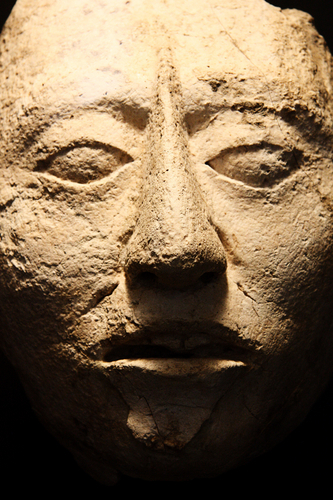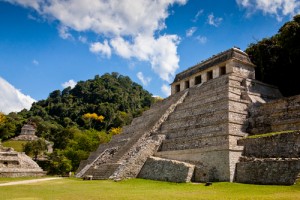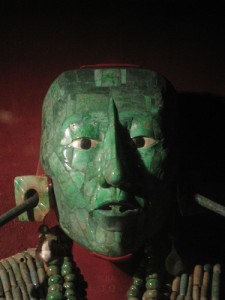 This story begins in darkness—darkness both literal and metaphorical. On a dripping wet day in 1952, an archaeologist stood in a small dank corridor deep inside a pyramid known as Temple of the Inscriptions, in the old Maya city of Palenque. In the shadows ahead, a massive triangular stone door blocked his way. For four field seasons, Alberto Ruz Lhuillier and his Maya crew had cleared tons of rubble and fill from steep steps leading down inside the pyramid. The archaeologist had no idea where the steps would take them, only a persistent thought that it could be somewhere important.
This story begins in darkness—darkness both literal and metaphorical. On a dripping wet day in 1952, an archaeologist stood in a small dank corridor deep inside a pyramid known as Temple of the Inscriptions, in the old Maya city of Palenque. In the shadows ahead, a massive triangular stone door blocked his way. For four field seasons, Alberto Ruz Lhuillier and his Maya crew had cleared tons of rubble and fill from steep steps leading down inside the pyramid. The archaeologist had no idea where the steps would take them, only a persistent thought that it could be somewhere important.
The crew struggled another two days with the door, finally shifting it enough for a man to squeeze sideways past. As Ruz moved beyond it, he shone a flashlight into the void. “It was a moment,” he later wrote, “of indescribable emotion.”
 In the blackness, past a curtain of ghostly white stalactites, lay a huge vaulted chamber. Along the walls loomed larger-than-life human figures – moulded stucco reliefs of the nine lords of the Maya underworld. Ruz ducked under the stalactites. In the centre of the chamber lay a massive stone carved with human figurines and row upon row of hieroglyphs.
In the blackness, past a curtain of ghostly white stalactites, lay a huge vaulted chamber. Along the walls loomed larger-than-life human figures – moulded stucco reliefs of the nine lords of the Maya underworld. Ruz ducked under the stalactites. In the centre of the chamber lay a massive stone carved with human figurines and row upon row of hieroglyphs.
Ruz thought the stone was some sort of ceremonial altar. But to be sure, he threaded a small wire into a hole in the carved slab, then eased it out: particles of brilliant red powder clung to its length – cinnabar, a pigment Maya mourners scattered in the tombs of Maya kings. Ruz and his team knew then that they had found a royal sarcophagus, and when they finally managed to roll the great lid to one side, they discovered the skeletal remains of a king buried in a mask of the finest green jade.
But who was he? No one knew. Epigraphers of the day were unable to read the inscriptions carved into the sarcophagus lid. Indeed, they were still struggling to crack the Maya script, with its 800 or so glyphs, some resembling stylized animal heads and human skulls. About all that the epigraphers could read with confidence was the simple dot-and-bar number system that Maya scribes had used to record dates and astronomical events.
In the early 1970s, however, a trio of Maya researchers– artist Linda Schele, linguist Floyd Lounsbury, and student Peter Mathews—made a huge epigraphic breakthrough. At a small conference in the nearby colonial town of Palenque, the three epigraphers identified a glyph that served as prefix to personal names in the Palenque inscriptions. This glyph was a royal title of some sort. And in the glyphs that adorned the Temple of the Inscriptions, this prefix often preceded a logograph, a symbol that represented an entire word. The symbol in question depicted a small distinctive shield worn by ancient Maya warriors in battle scenes. The three epigraphers began calling the man in the jade mask Lord Shield.
As the research proceeded, others noticed a variant glyph for Lord Shield’s name, a glyph composed of three phonetic-syllabic signs—“pa-ca-l(a).” It was a word in the language of the Yucatec Maya: pacal, meaning “shield.” After years of struggle, epigraphers had discovered the Palenque king’s Maya name: Pacal.
 Today, thanks to such stubborn research, we know much more about Pacal–the date of his birth, A.D. 615, the year in which he ascended to the throne, the length of his reign, who he married, the names of sons, the names of the lords he defeated in battle, and the date of his death. But it wasn’t until I watched a recent talk given by two brilliant Mayan epigraphers – George Stuart and his son David Stuart— that I began to understand why the Maya of Palenque had so worshipped Pacal.
Today, thanks to such stubborn research, we know much more about Pacal–the date of his birth, A.D. 615, the year in which he ascended to the throne, the length of his reign, who he married, the names of sons, the names of the lords he defeated in battle, and the date of his death. But it wasn’t until I watched a recent talk given by two brilliant Mayan epigraphers – George Stuart and his son David Stuart— that I began to understand why the Maya of Palenque had so worshipped Pacal.
During the talk, David Stuart modestly described “a stab” he had taken at translating a group of hieroglyphs carved on the facade of the Temple of the Inscriptions, Pacal’s mortuary shrine. A celebration of the king’s greatest achievement, the ancient text reads like pure poetry—elusive, esoteric, exquisite, freighted with meaning:
He rules, the Shiny-Sky Maize (the God of 12).
The Shiny-Jewel Tree sprouts
The Five-?-Tree sprouts.
It is the Heavenly Load.
It is the Earthly Load.
Jade collars,
Jade ear-ornaments (are bestowed upon)
…The Dynastic Lords.
During his long reign, Pacal, explained Stuart, had vanquished many of his royal rivals in the region, bringing not just peace, but immense wealth to Palenque. A river of tribute –rich jade –flowed into the royal court of Palenque in a way never seen before. “The tree of jade is sprouting,” said Stuart. “Riches are just pouring all over Palenque, and the gods are pleased, the cosmos is pleased, and the dynastic lords are being dressed and adorned with all of this finery.”
Pacal’s reign marked the heady zenith of Palenque’s power, a time of opulence and splendor, when all seemed utterly right with the world and with the Maya. It didn’t last long: such moments in time never do. A little more than a century after Pacal was interred in his sumptuous tomb, his great city collapsed, cause pretty much unknown.
The shiny-jewel tree had fallen.
Photos: Ancient Maya sculpture from Shutterstock; Temple of Palenque from Shutterstock; Pacal’s jade mask from Patt.Meeples photostream at Flickr.
You’ve done it again Heather! Once again an informative, wonderful piece of writing.
Blessings of Peace,
Al
Al: Thanks so much! It’s a bleak looking day here in Vancouver, and your words have warmed my heart.
Best
Heather